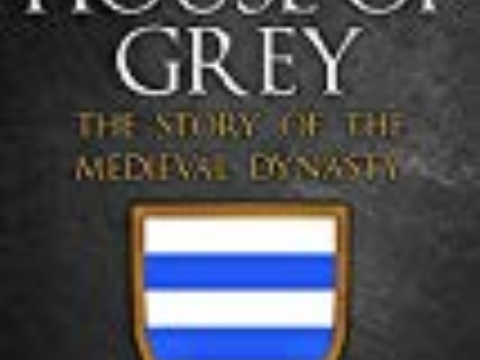Wales & the Wars of the Roses
Chapter 3 : Welsh Lancastrians & Yorkists
Not all Welshmen supported Glyndwr, a notable exception being Dafydd ap Llywelyn (sometimes referred to as Dafydd Gam), one of Henry IV’s strongest supporters in Wales. Captured by Glyndwr, he was ransomed, and went on to fight at Agincourt. His daughter, Gwladys ferch Dafydd, married first, Sir Roger Vaughan, and then William ap Thomas of Raglan. Gwladys’ sons played an important role in the Wars of the Roses, and, from having been members of Jasper Tudor’s Council, became his sworn enemies.
The advent of Henry V brought a slight improvement in Anglo-Welsh relations – Henry was far more interested in conquering France than he was in the rocky uplands of Wales, and, although the Penal Laws were not abolished, they were imposed less harshly.
It is against this back-drop of the Welsh wars that the secret marriage of Katherine de Valois, widow of Henry V, needs to be seen. Owain Tudor, who may have been in Henry V’s army or household at one time, was the son of Owain Glyndwr’s cousin. It was no wonder that the King’s relatives, particularly his brother, Humphrey of Gloucester, were horrified. Not just Owain’s relative poverty and nationality, but that he was closely related to the arch-rebel himself, made a bitter pill.
Owain’s sons, Edmund and Jasper, were brought up as English aristocrats, rather than the descendants of Welsh princes. After Katherine’s death, Owain had been imprisoned and then harried back to Wales, so Jasper’s childhood memories of his father were probably dim. Nevertheless, Owain came to feel as grateful to his step-son, Henry VI, as Edmund and Jasper did. Once he was old enough, the King pardoned Owain for his offence in marrying Katherine, and treated him honourably. The King also granted Edmund and Jasper the valuable earldoms of Richmond and Pembroke respectively, as well as the wardship of his wealthy cousin, Lady Margaret Beaufort.
No details are known of Owain and Jasper Tudor’s personal relationship, other than that they fought together at Mortimer’s Cross, and that Jasper revenged himself on the man who ordered Owain’s execution. In his will, Jasper gave money to the church in which Owain was buried – the Greyfriars at Hereford.
So at the outbreak of hostilities, there were Lancastrian supporters, such as Jasper Tudor and Dafydd Gam, and others who were mindful of the Mortimer claim to the throne, now embodied in Richard, Duke of York. But cutting across any loyalty to English royal houses, were the conflicts and quarrels of a small society, widely inter-married, with competing loyalties, where blood feuds could continue for generations.
A case in point is the Herbert family, who became Jasper’s greatest rivals for influence in South Wales. Sir William Herbert (known in Welsh as Gwilym Ddu – Black Will) was the son of Thomas ap Gwilym, who created the mighty edifice of Raglan Castle. Thomas ap Gwilym’s second wife, and the mother of William, was Gwladys, daughter of Dafydd Gam with whom he had fought at Agincourt, together with Gwladys’ first husband, Roger Vaughan.
Gwladys was a great patron of the traditional Welsh bardic culture, and was much feted in poetry, called ‘the Star of Abergavenny’ probably as much for her generosity to the bards as for her beauty. William Herbert inherited this taste, and his court at Raglan Castle was very much a traditional Welsh court.
Given their parents’ Lancastrian associations, it might have been expected, therefore, that William Herbert and his Vaughan half-brothers (Walter, Thomas and Roger) would be Lancastrians, but all of them became adherents of York, with William Herbert also marrying Anne Devereux, daughter of Sir Walter Devereux, Lord Chancellor of Ireland, who held lands from York, and served under him.
William Herbert and another Thomas Vaughan (not his half-brother, but probably a relative) were members of Jasper’s Council as Earl of Pembroke in the mid-1450s but the relationship broke down at some point.
It may be that the Herberts and Vaughans resented the incursion of Edmund and Jasper Tudor, brought up as English aristocrats, whose Welsh family were from the north, and who had no local affinity. Whilst this is mere speculation, it is not difficult to imagine that the Tudor brothers, in their early twenties, half-brothers to the King and probably brought up to think of any Welshman other than their father as being practically a savage, might have thrown their weight about in a way that aggravated experienced men and drove them into the arms of York.
Additionally, with York having a wide range of estates, not just those in Wales, he was more likely to hand over power and responsibility to Herbert and his family, whilst the Tudors seemed inclined to remain on the spot.
Regardless of how they arrived at their decision, Herbert and the Vaughans supported York faithfully, carrying that allegiance over to Edward IV. Black Will Herbert grew hugely in influence during the reign of Edward IV. Despite the twenty year age gap, the men became friends, and Herbert was granted extensive power and position, including the wardship of Jasper’s nephew, Henry Tudor, after the Battle of Mortimer’s Cross in 1461, which must have been a bitter blow for Jasper, and Jasper’s earldom of Pembroke in 1468 after Herbert finally captured Harlech Castle.
The young Henry Tudor lived from the age of four until he was twelve, at Herbert’s seat at Raglan, together with Herbert’s children, another William, Maud (whom it was thought that Henry would marry) and Katherine. Henry Tudor was not Herbert’s only Lancastrian ward – there was also Henry Percy, Earl of Northumberland, a very valuable prize. As a further mark of favour from Edward IV, William Herbert the Younger, was married to Edward IV’s own sister-in-law, Mary Woodville, in 1466.


